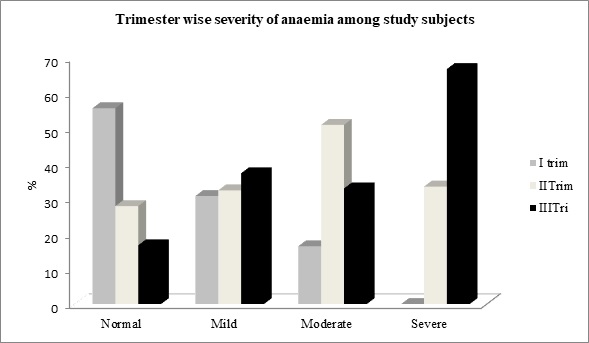Hemoglobin profile of full term pregnant women admitted for delivery in a teaching hospital: a case series study
Abstract
Background: Anemia in pregnancy is a common and serious public health problem in developing countries. It is associated with high incidence of premature births, postpartum hemorrhage, puerperal sepsis, etc in mother.
Objective: 1) To assess the hemoglobin profile of full term pregnant women admitted for delivery. 2) To analyze the correlation of anemia with obstetrics parameters like gravida, parity, and history of abortions in the past.
Methods: The present case series study was conducted among the pregnant women in latent stage of labor admitted in a teaching hospital by using pre- designed, pre- tested, structured schedule. Hemoglobin estimation was done by Shali’s method and anemia was classified according to WHO criteria. Statistical analyses were done by percentages and proportions, Mean and Chi- square test.
Results: A high prevalence (88.4%) of anemia (Hb% - < 11.0 gm/dl) was observed among 130 pregnant women at labor. Majority (58.5%) had moderate degree of anemia (Hb%– 7.0 to 10.0 gm/dl) and (04.6%) had severe anemia (Hb% - < 7 gm/dl). The study observed significantly higher prevalence of anemia among those pregnant women who studied upto secondary level (90.3%), and those from below class IV socio- economic status (96%), among those cases less than one year of spacing between previous and index pregnancies (90%).
Conclusion: Monitoring the compliance of women with ante- natal care services and strengthening of their health care seeking behavior are important health care measures to be undertaken at the community level.
Downloads
References
2. Sharma J B and Shankar M. Anemia in pregnancy. Journal of International Medical Sciences Academy 2010;23(4):253-260.
3. Viveki R G, Halappanavar A B, Viveki P R, Halki S B, Maled V S and Deshpande P S. Prevalence of Anaemia and its Epidemiological Determinants in pregnant women. Al Ameen J Med Sci 2012;5(3):216-223.
4. Tiwan Lt M, Col Jyothi, Anupam K, Mishra M P, Dutta B V, Chopra B S. Correlation of haemoglobin and red cell indices with serum ferritin in indian women in second and third trimester of pregnancy. Medical journal armed forces India 2013;69:31-36.
5. Labour Bureau Government of India, Consumer price index. Available at www.labourbureau.nic.in (last accessed on 15/10/2015).
6. Yadav R K, Swamy M K and Banjade B. Knowledge and Practice of Anemia among pregnant women attending antenatal clinic in Dr. Prabhakar Kore hospital, Karnataka-A Cross sectional study. IOSR Journal of Dental and Medical Sciences 2014;13(4):74-80.
7. Baig-Ansari N, Badruddin SH, Karmaliani R, Harris H, Jehan I, Pasha O, Moss N, McClure EM, Goldenberg RL.. Anemia prevalence and risk factors in pregnant women in an urban area of Pakistan. Food Nutr Bull. 2008 Jun;29(2):132-9.
8. Umar Z, Rasool M, Asif M, Karim S, Malik A, Mushtaq G et.al. Evalution of hemoglobin concentration in pregnancy and correlation with different altitude: A study from balochistan plateau of Pakistan. The open Biochemistry Journal 2015;9:7-14.
9. Taner CE, Ekin A, Solmaz U, Gezer C, Çetin B, Keleşoğlu M, Erpala MB, Özeren M. Prevalence and risk factors of anemia among pregnant women attending a high-volume tertiary care center for delivery. J Turk Ger Gynecol Assoc. 2015 Nov 2;16(4):231-6. doi: 10.5152/jtgga.2015.15071. eCollection 2015.
10. NFHS-2. National Family Health Survey (NFHS-2), 1998-1999, India, Mumbai: Indian Institute of Population studies: 2000.
11. Bentley ME, Griffiths PL. The burden of anemia among women in India. Eur J Clin Nutr. 2003 Jan;57(1):52-60.
12. Gautam V P, Bansal Y, Taneja D K, Saha R. Prevalence of anemia amongst pregnant women and its socio- demographic associates in a rural area of delhi. Indian J comm Med 2010;XXVII(4):157-160.

Copyright (c) 2016 Author (s). Published by Siddharth Health Research and Social Welfare Society

This work is licensed under a Creative Commons Attribution 4.0 International License.


 OAI - Open Archives Initiative
OAI - Open Archives Initiative


